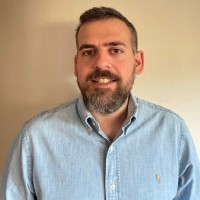Spyros Lavdas, PhD
Assistant Professor and Cybersecurity Coordinator, Deree - ACG
CONTACT INFO
Spyros Lavdas graduated in electrical and computer engineering from the Faculty of Engineering, Democritus University of Thrace (DUTH), Xanthi, Greece, in 2009. He received the Postgraduate Diploma degree in computational electromagnetics from the Department of Computer Systems and Satellite Telecommunications, DUTH, in 2012, and the Ph.D. degree in silicon photonics from the Department of Electronic and Electrical Engineering, University College London (UCL), in 2015. He has academic experience of teaching undergraduate and postgraduate students in the courses of microwaves, optical nonlinearities and problem-solving methods. He is currently serving as Assistant Professor and Cybersecurity coordinator at American College of Greece. His main research interests include the area of computational electromagnetics, silicon photonics, nanoantennas, 5G and 6G communications IoT and implementations of machine learning techniques in wireless networks.
Teaching activities: ITC2024, ITC3231, ITC 2101, ITC 1070
ORCID iD: https://orcid.org/0000-0002-6228-6724
Publications
- K. Gkonis, S. Lavdas, G. Vardoulias, Z. Zinonos, P. Trakadas, L. Sarakis and K. Papadopoulos, “Adaptive Beamforming, Cell-Free Resource Allocation and NOMA in Large-Scale Wireless Networks,” Sensors2024, 24, 7548. https://doi.org/10.3390/s24237548.
- K. Gkonis, S. Lavdas, G. Vardoulias, P. Trakadas, L. Sarakis and K. Papadopoulos, “System Level Performance Assessment of Large-Scale Cell-Free Massive MIMO Orientations With Cooperative Beamforming,” in IEEE Access, vol. 12, pp. 92073-92086, 2024, doi: 10.1109/ACCESS.2024.3422349.
- Lavdas, P. K. Gkonis, Z. Zinonos, P. Trakadas, L. Sarakis and K. Papadopoulos, “A Machine Learning Framework for Adaptive Beamforming in Massive MIMO Millimeter 5G Wave Multicellular Networks,” in IEEE Access, vol. 10, pp. 91597-91609, 2022, doi: 10.1109/ACCESS.2022.3202640.
- Lavdas, P. K. Gkonis, Z. Zinonos, P. Trakadas, L. Sarakis and K. Papadopoulos, “A Machine Learning Adaptive Beamforming Framework for 5G Millimeter Wave Massive MIMO Multicellular Networks,” in IEEE Access, vol. 10, pp. 91597-91609, 2022, doi: 10.1109/ACCESS.2022.3202640.
- Charilaou, S. Lavdas, Ala F. Khalifeh, V. Vasilliou and Z. Zinonos, “Firmware Update Using Multiple Gateways in LoRaWAN Networks”, Sensors, vol. 21, no.19,2021, doi: 10.3390/s21196488
- Lavdas, P. K. Gkonis, Z. Zinonos, P. Trakadas and L. Sarakis, “An Adaptive Hybrid Beamforming Approach for 5G-MIMO mmWave Wireless Cellular Networks,” in IEEE Access, vol. 9, pp. 127767-127778, 2021, doi: 10.1109/ACCESS.2021.3112514.
- Lavdas, D. Sklavounos, N. Bakas, P. Gkonis, V. Goltsi and P. Siaperas, “A machine learning implementation to multiple sclerosis signal conduction through nervous system for decision support”, 2023 2nd International Rehabilitation Conference, pp. 104-11.
- Lavdas, D. Sklavounos, P. Gkonis, P. Siaperas and N. Bakas, “Identification of Multiple Sclerosis Signals Dependence on Patients’ Medical Conditions Through Stochastic Perturbation of Features in Five Machine Learning Models”, 2023 19th European Mediterranean & Middle Eastern Conference on Information Systems (EMCIS) Conference, vol. 464, doi: https://doi.org/10.1007/978-3-031-30694-5_5.
- Lavdas, P. Gkonis, Z. Zinonos, P. Trakadas and L. Sarakis, ” Throughput Based Adaptive Beamforming in 5G Millimeter Wave Massive MIMO Cellular Networks via Machine Learning”, 2022 IEEE 95th Vehicular Technology Conference: (VTC2022-Spring), 2022, pp. 1-7, doi: 10.1109/VTC2022-Spring54318.2022.9860566.
- Lavdas, L. Zacharioudakis, A. Khalifeh and Z. Zinonos, “The Effect of Temperature and Humidity on Indoor LoRa Propagation Model,” 2021 17th International Conference on Distributed Computing in Sensor Systems (DCOSS), (2021), pp. 374-379, doi: 10.1109/DCOSS52077.2021.00066.
